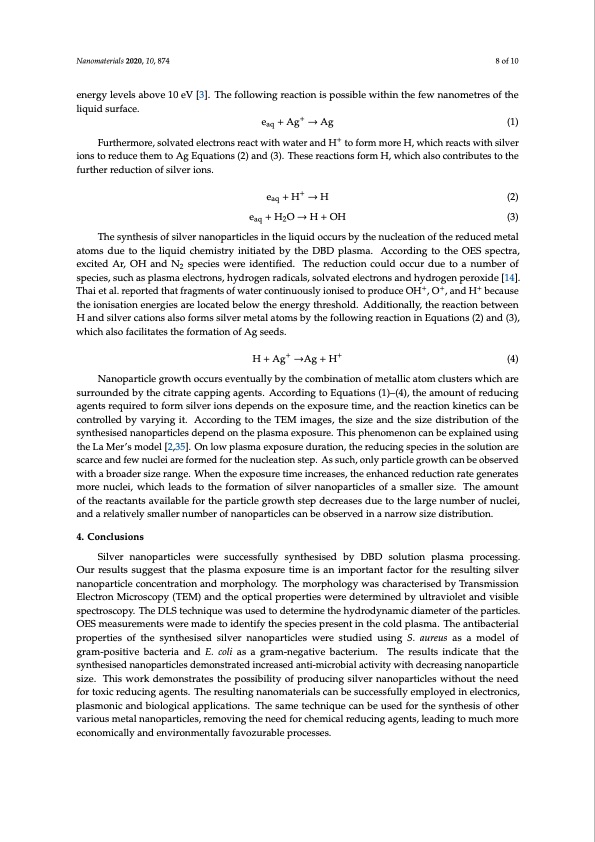
PDF Publication Title:
Text from PDF Page: 008
Nanomaterials 2020, 10, 874 8 of 10 energy levels above 10 eV [3]. The following reaction is possible within the few nanometres of the liquid surface. eaq +Ag+ →Ag (1) Furthermore, solvated electrons react with water and H+ to form more H, which reacts with silver ions to reduce them to Ag Equations (2) and (3). These reactions form H, which also contributes to the further reduction of silver ions. eaq + H+ → H (2) eaq +H2O→H+OH (3) The synthesis of silver nanoparticles in the liquid occurs by the nucleation of the reduced metal atoms due to the liquid chemistry initiated by the DBD plasma. According to the OES spectra, excited Ar, OH and N2 species were identified. The reduction could occur due to a number of species, such as plasma electrons, hydrogen radicals, solvated electrons and hydrogen peroxide [14]. Thai et al. reported that fragments of water continuously ionised to produce OH+, O+, and H+ because the ionisation energies are located below the energy threshold. Additionally, the reaction between H and silver cations also forms silver metal atoms by the following reaction in Equations (2) and (3), which also facilitates the formation of Ag seeds. H+Ag+ →Ag+H+ (4) Nanoparticle growth occurs eventually by the combination of metallic atom clusters which are surrounded by the citrate capping agents. According to Equations (1)–(4), the amount of reducing agents required to form silver ions depends on the exposure time, and the reaction kinetics can be controlled by varying it. According to the TEM images, the size and the size distribution of the synthesised nanoparticles depend on the plasma exposure. This phenomenon can be explained using the La Mer’s model [2,35]. On low plasma exposure duration, the reducing species in the solution are scarce and few nuclei are formed for the nucleation step. As such, only particle growth can be observed with a broader size range. When the exposure time increases, the enhanced reduction rate generates more nuclei, which leads to the formation of silver nanoparticles of a smaller size. The amount of the reactants available for the particle growth step decreases due to the large number of nuclei, and a relatively smaller number of nanoparticles can be observed in a narrow size distribution. 4. Conclusions Silver nanoparticles were successfully synthesised by DBD solution plasma processing. Our results suggest that the plasma exposure time is an important factor for the resulting silver nanoparticle concentration and morphology. The morphology was characterised by Transmission Electron Microscopy (TEM) and the optical properties were determined by ultraviolet and visible spectroscopy. The DLS technique was used to determine the hydrodynamic diameter of the particles. OES measurements were made to identify the species present in the cold plasma. The antibacterial properties of the synthesised silver nanoparticles were studied using S. aureus as a model of gram-positive bacteria and E. coli as a gram-negative bacterium. The results indicate that the synthesised nanoparticles demonstrated increased anti-microbial activity with decreasing nanoparticle size. This work demonstrates the possibility of producing silver nanoparticles without the need for toxic reducing agents. The resulting nanomaterials can be successfully employed in electronics, plasmonic and biological applications. The same technique can be used for the synthesis of other various metal nanoparticles, removing the need for chemical reducing agents, leading to much more economically and environmentally favozurable processes.PDF Image | Bactericidal Silver Nanoparticles by Plasma Processing

PDF Search Title:
Bactericidal Silver Nanoparticles by Plasma ProcessingOriginal File Name Searched:
nanomaterials-10-00874.pdfDIY PDF Search: Google It | Yahoo | Bing
Turbine and System Plans CAD CAM: Special for this month, any plans are $10,000 for complete Cad/Cam blueprints. License is for one build. Try before you buy a production license. More Info
Waste Heat Power Technology: Organic Rankine Cycle uses waste heat to make electricity, shaft horsepower and cooling. More Info
All Turbine and System Products: Infinity Turbine ORD systems, turbine generator sets, build plans and more to use your waste heat from 30C to 100C. More Info
CO2 Phase Change Demonstrator: CO2 goes supercritical at 30 C. This is a experimental platform which you can use to demonstrate phase change with low heat. Includes integration area for small CO2 turbine, static generator, and more. This can also be used for a GTL Gas to Liquids experimental platform. More Info
Introducing the Infinity Turbine Products Infinity Turbine develops and builds systems for making power from waste heat. It also is working on innovative strategies for storing, making, and deploying energy. More Info
Need Strategy? Use our Consulting and analyst services Infinity Turbine LLC is pleased to announce its consulting and analyst services. We have worked in the renewable energy industry as a researcher, developing sales and markets, along with may inventions and innovations. More Info
Made in USA with Global Energy Millennial Web Engine These pages were made with the Global Energy Web PDF Engine using Filemaker (Claris) software.
Infinity Turbine Developing Spinning Disc Reactor SDR or Spinning Disc Reactors reduce processing time for liquid production of Silver Nanoparticles.
| CONTACT TEL: 608-238-6001 Email: greg@infinityturbine.com | RSS | AMP |